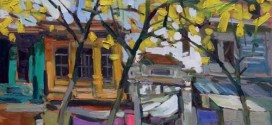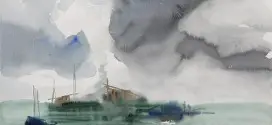Since the 1950s, installation and performance are two branches of contemporary art that have become important facets of mainstream art. Vietnam’s modern artists, forever innovators, are at the forefront of expanding installation and performance art into new realms.
First appearing in Vietnam in the early 1990’s, several small installations and performance shows first appeared at an out-of-the-way corner of Buoi Street, Hanoi, at the stilt house of painter Nguyen Minh Duc. For many years, this was where new art exhibitions, seminars, and meetings of the contemporary art community took place. The stilt house quickly became known as a generator for the country’s fledgling contemporary art scene.
Shortly thereafter, international cultural centers began to establish, further pushing the growth of modern art. In late 1991, the Center for French Language and Culture (Alliance Francaise) was founded and made its headquarters near Hanoi University of Art, No. 42 Yet Kieu Street. The British Council came next, first operating in early 1993, while the Goethe Institute was established by Germany in early 1997. In the following years, many contemporary art programs of both Vietnamese and foreign artists have been produced and presented at these cultural centers.
At the beginning of 2001, the Hanoi Contemporary Art Center was founded under the joint-sponsorship of the Vietnam Association of Art and the Ford Foundation. In less than three years, the center had taken a center role in contributing to domestic exhibitions, foreign relations, and in supporting student experimental art projects. The center’s arrival, along with Duc’s stilt house, has fostered a healthy environment for the growth of experiment art in Hanoi and in Vietnam.
The year 2003 marked a big step in the progress of modern are with the birth of L’Espace from former Alliance Francaise, headquartered at No.24 Trang Tien Street, Hanoi. L’Espace, with its exhibition halls, small theater, and large library, is example of maximized foreign support of Vietnam modern art. In early 2004, the Goethe Institute moved to No.56 Nguyen Thai Hoc Street, Hanoi. The Goethe’s relocation was inaugurated with a very impressive and successful installation art show called “Green, Red, and Yellow”. Dozens of Vietnamese and foreign artists contributed to the show. Since mid-2004, the British Council in Hanoi has also supported a series of experimental art projects, bringing together many Vietnamese and British artists. One such production was the fashion show “Street Symphony”, which combined music, sound, visual images and light with modern fashion. The show was a success in Hanoi and later in the year toured at the Hue festivals. In the year 2005, contemporary art continued to spread across the nation’s galleries and studios. Though a relatively small movement, modern art in Vietnam increasingly attracts young artists. In the meantime, the general public has had the time to familiarize with the new art trend. In Hanoi, the newly created Ryllega Gallery at 1A Trang Tien Street has quickly become reliable space for experimental art, exposing the interested public to new art trends and artists. During the Hue festival, the New Space Art Gallery at No.7 Pham Ngu Lao Street opened a series of installation and performance art exhibitions and activities.
Meanwhile, in Ho Chi Minh City, many small galleries and studios have supported some artists in realizing their art experiments. For example, A Little Blah Blah, Atelier Wonderful, Gallery Quynh, Green Space at the Art Museum, and Himiko Visual Saloon, are all spaces in HCMC that support modern art events. The upcoming Saigon Open City Center, sponsored by the Ford Foundation, has turned an old factory neat the Saigon River into a place for large scale installation and performance exhibitions.
In Hanoi, since early 2006, those interested in contemporary art have witnessed the appearance of the Viet Art Center at No. 42 Yet Kieu Street near Hanoi University of Art. This past July, there was a beautiful and inspiring installation exhibit called “Books”. From September until the end of October this year, the Viet Art Center is collaborating with the Center for Prehistoric South East Asia and the Hanoi University of Art to organize an exhibition of photos and documents about a Sapa ancient carved stone site. This result is a fusion of art an archaeological research.
Today the expansion of contemporary art continues. By the end of this year, Vietnam Red Space will be completed on the large site of world-renowned Anh Khanh’s studio on Hanoi. The space will be reserved for experimental art activities and exchange programs between Vietnamese and foreign artists. In addition, an artist residency program known as “Campus” has proven a popular stamping ground for Hanoi’s modern artists since its inception last year. Local artists come to collaborate with foreign resident artists, to experiment with each other in different artistic mediums, to participate in free English classes, or simply to gain the friendship and guidance of Marcus Mitchell, the program’s charming director.
As developments flourish, modern art continues to expand in Vietnam, the impact of such through institutional support of the arts reverberated throughout Vietnam’s art world and, more broadly, for art enthusiasts everywhere.
 Vietnamese Culture and Tradition
Vietnamese Culture and Tradition 

